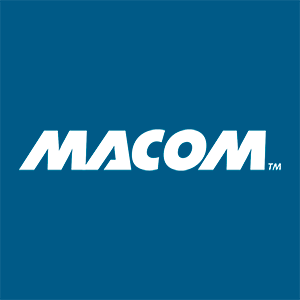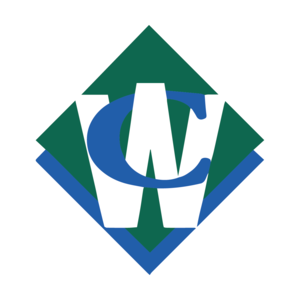
Comfort Systems (FIX)
Comfort Systems is in a league of its own. Its strong sales growth and returns on capital show it’s capable of quick and profitable expansion.― StockStory Analyst Team
1. News
2. Summary
Why We Like Comfort Systems
Formed through the merger of 12 companies, Comfort Systems (NYSE:FIX) provides mechanical and electrical contracting services.
- Annual revenue growth of 23.7% over the past five years was outstanding, reflecting market share gains this cycle
- Performance over the past five years shows its incremental sales were extremely profitable, as its annual earnings per share growth of 45% outpaced its revenue gains
- Notable projected revenue growth of 18% for the next 12 months hints at market share gains


We’re optimistic about Comfort Systems. The valuation seems reasonable when considering its quality, and we believe now is the time to invest in the stock.
Why Is Now The Time To Buy Comfort Systems?
High Quality
Investable
Underperform
Why Is Now The Time To Buy Comfort Systems?
Comfort Systems’s stock price of $1,008 implies a valuation ratio of 32.1x forward P/E. Valuation is above that of many industrials companies, but we think the price is justified given its business fundamentals.
Our analysis and backtests show it’s often prudent to pay up for high-quality businesses because they routinely outperform the market over a multi-year period almost regardless of the entry price.
3. Comfort Systems (FIX) Research Report: Q3 CY2025 Update
HVAC and electrical contractor Comfort Systems (NYSE:FIX) reported Q3 CY2025 results topping the market’s revenue expectations, with sales up 35.2% year on year to $2.45 billion. Its GAAP profit of $8.25 per share was 32.4% above analysts’ consensus estimates.
Comfort Systems (FIX) Q3 CY2025 Highlights:
- Revenue: $2.45 billion vs analyst estimates of $2.17 billion (35.2% year-on-year growth, 13.2% beat)
- EPS (GAAP): $8.25 vs analyst estimates of $6.23 (32.4% beat)
- Adjusted EBITDA: $413.9 million vs analyst estimates of $323.7 million (16.9% margin, 27.8% beat)
- Operating Margin: 15.5%, up from 11.2% in the same quarter last year
- Free Cash Flow Margin: 21.2%, up from 15.6% in the same quarter last year
- Backlog: $9.38 billion at quarter end, up 65.1% year on year
- Market Capitalization: $27.84 billion
Company Overview
Formed through the merger of 12 companies, Comfort Systems (NYSE:FIX) provides mechanical and electrical contracting services.
The company specializes in the design, installation, maintenance, and repair of heating, ventilation, air conditioning (HVAC), and electrical systems for commercial, industrial, and institutional buildings across the United States. How else would the typical American office building keep its workers chilly and in need of a sweater during the sweltering summer months?
Additional product offerings include building automation and controls, energy retrofitting, plumbing and piping solutions, indoor air quality improvement equipment, and electrical and lighting services. Many of these are top-of-mind for customers who want to digitize their operations or improve energy efficiency efforts.
Historically, a major percentage of the company’s total revenue is attributed to installation services within newly-constructed facilities. Another meaningful portion of revenue is from the renovation, expansion, maintenance, repair, and replacement of its equipment in existing buildings. In addition to organic growth, acquisitions have also contributed to Comfort Systems' growth. For example, the company acquired electrical contracting service company Amteck in 2021 as well as a number of acquisitions in 2024.
4. Construction and Maintenance Services
Construction and maintenance services companies not only boast technical know-how in specialized areas but also may hold special licenses and permits. Those who work in more regulated areas can enjoy more predictable revenue streams - for example, fire escapes need to be inspected every five years. More recently, services to address energy efficiency and labor availability are also creating incremental demand. But like the broader industrials sector, construction and maintenance services companies are at the whim of economic cycles as external factors like interest rates can greatly impact the new construction that drives incremental demand for these companies’ offerings.
Comfort Systems USA's top competitors include EMCOR (NYSE:EME), Johnson Controls (NYSE:JCI), and Trane Technologies (NYSE:TT).
5. Revenue Growth
Examining a company’s long-term performance can provide clues about its quality. Any business can experience short-term success, but top-performing ones enjoy sustained growth for years. Thankfully, Comfort Systems’s 23.7% annualized revenue growth over the last five years was incredible. Its growth surpassed the average industrials company and shows its offerings resonate with customers, a great starting point for our analysis.
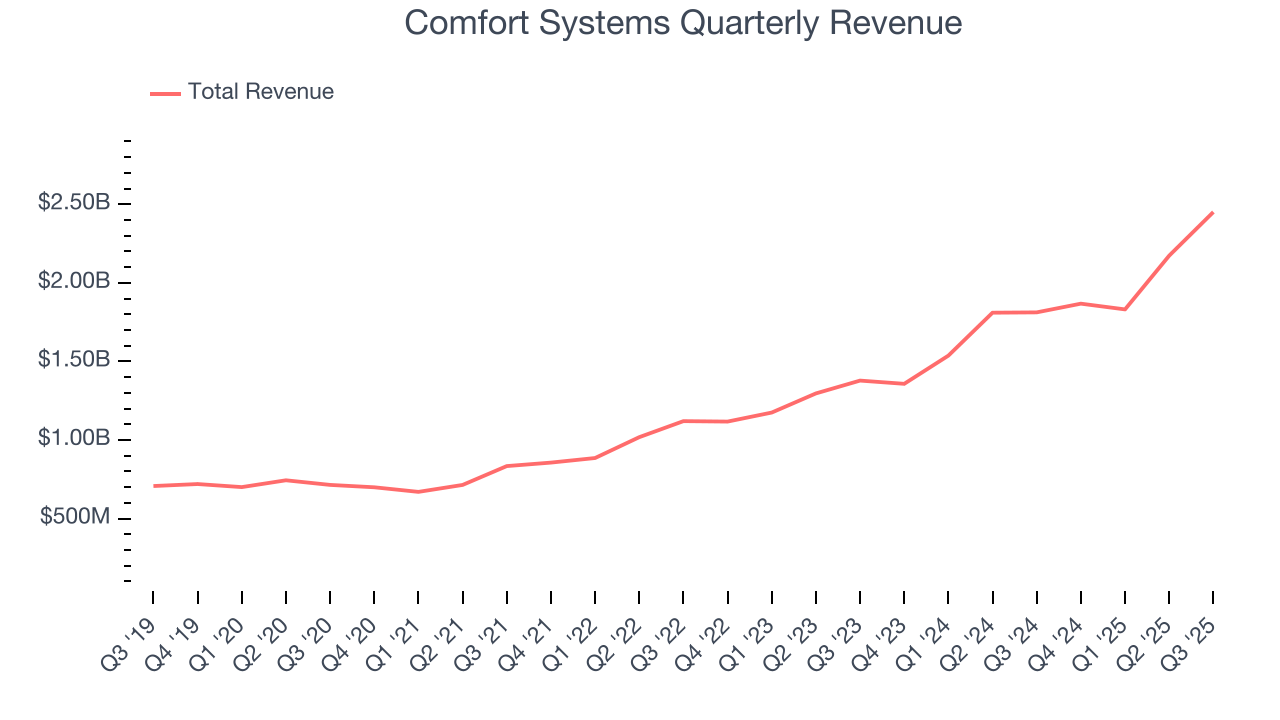
We at StockStory place the most emphasis on long-term growth, but within industrials, a half-decade historical view may miss cycles, industry trends, or a company capitalizing on catalysts such as a new contract win or a successful product line. Comfort Systems’s annualized revenue growth of 29.5% over the last two years is above its five-year trend, suggesting its demand was strong and recently accelerated. 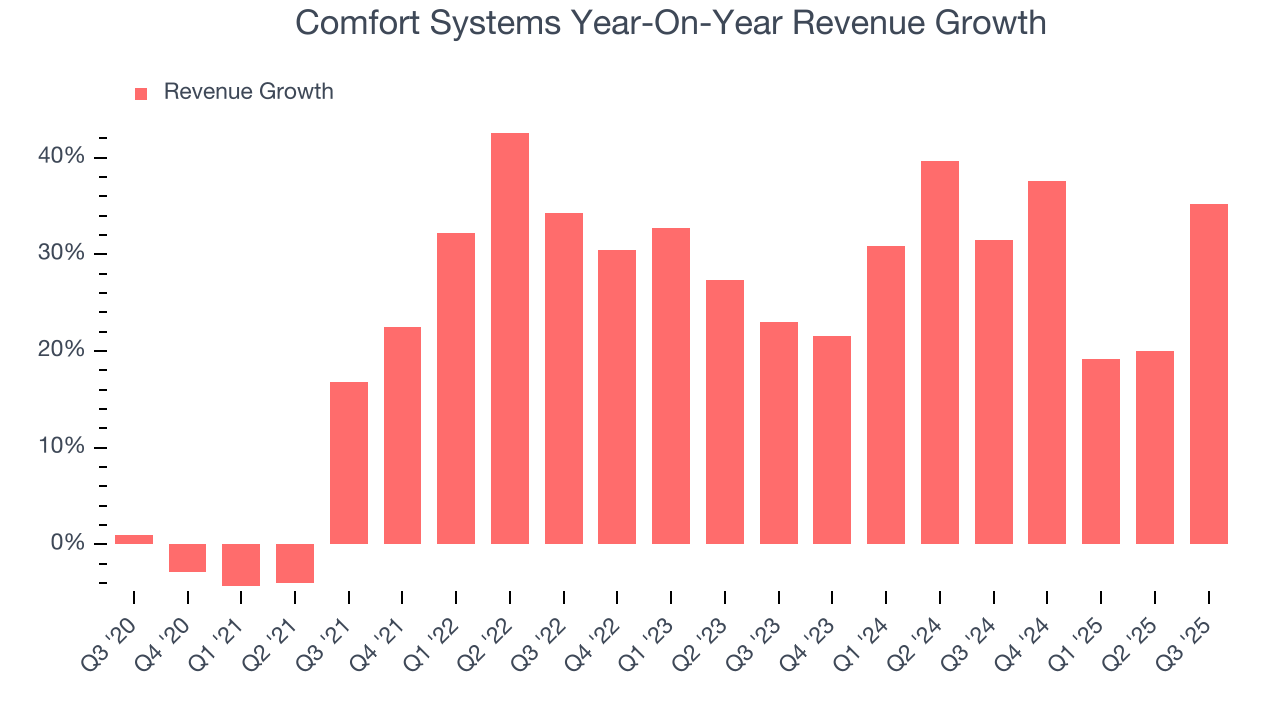
Comfort Systems also reports its backlog, or the value of its outstanding orders that have not yet been executed or delivered. Comfort Systems’s backlog reached $9.38 billion in the latest quarter and averaged 33.6% year-on-year growth over the last two years. Because this number is better than its revenue growth, we can see the company accumulated more orders than it could fulfill and deferred revenue to the future. This could imply elevated demand for Comfort Systems’s products and services but raises concerns about capacity constraints. 
This quarter, Comfort Systems reported wonderful year-on-year revenue growth of 35.2%, and its $2.45 billion of revenue exceeded Wall Street’s estimates by 13.2%.
Looking ahead, sell-side analysts expect revenue to grow 7.9% over the next 12 months, a deceleration versus the last two years. Despite the slowdown, this projection is above the sector average and implies the market sees some success for its newer products and services.
6. Gross Margin & Pricing Power
All else equal, we prefer higher gross margins because they make it easier to generate more operating profits and indicate that a company commands pricing power by offering more differentiated products.
Comfort Systems has bad unit economics for an industrials business, signaling it operates in a competitive market. As you can see below, it averaged a 20.4% gross margin over the last five years. That means Comfort Systems paid its suppliers a lot of money ($79.61 for every $100 in revenue) to run its business. 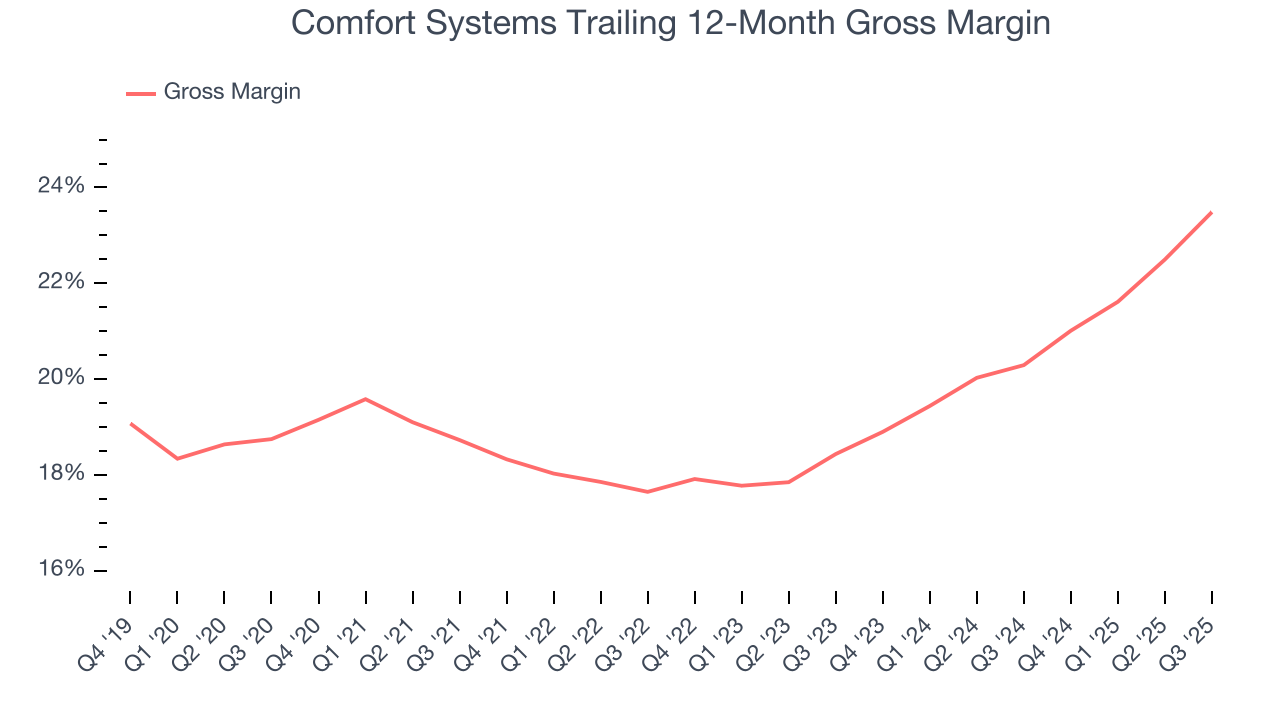
Comfort Systems’s gross profit margin came in at 24.8% this quarter, marking a 3.7 percentage point increase from 21.1% in the same quarter last year. Comfort Systems’s full-year margin has also been trending up over the past 12 months, increasing by 3.2 percentage points. If this move continues, it could suggest better unit economics due to more leverage from its growing sales on the fixed portion of its cost of goods sold (such as manufacturing expenses).
7. Operating Margin
Comfort Systems has done a decent job managing its cost base over the last five years. The company has produced an average operating margin of 9.6%, higher than the broader industrials sector.
Analyzing the trend in its profitability, Comfort Systems’s operating margin rose by 7 percentage points over the last five years, as its sales growth gave it immense operating leverage.

In Q3, Comfort Systems generated an operating margin profit margin of 15.5%, up 4.3 percentage points year on year. The increase was encouraging, and because its operating margin rose more than its gross margin, we can infer it was more efficient with expenses such as marketing, R&D, and administrative overhead.
8. Earnings Per Share
Revenue trends explain a company’s historical growth, but the long-term change in earnings per share (EPS) points to the profitability of that growth – for example, a company could inflate its sales through excessive spending on advertising and promotions.
Comfort Systems’s EPS grew at an astounding 43.8% compounded annual growth rate over the last five years, higher than its 23.7% annualized revenue growth. This tells us the company became more profitable on a per-share basis as it expanded.
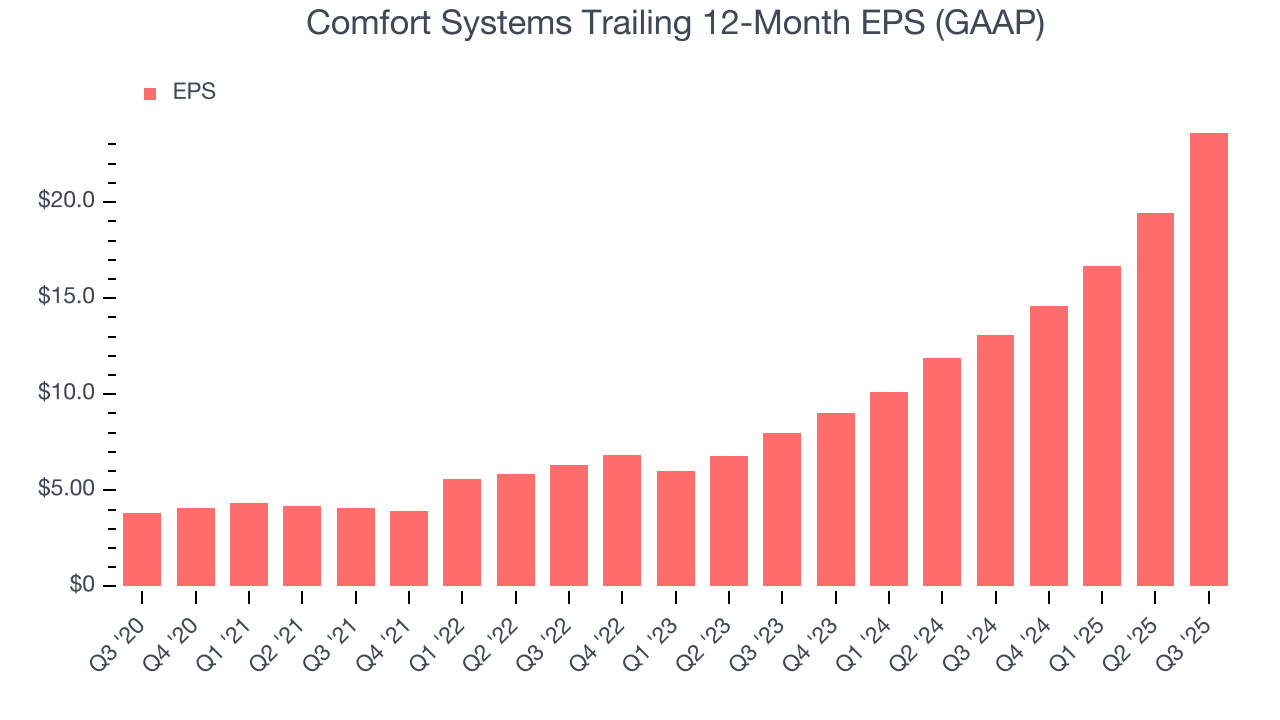
We can take a deeper look into Comfort Systems’s earnings quality to better understand the drivers of its performance. As we mentioned earlier, Comfort Systems’s operating margin expanded by 7 percentage points over the last five years. On top of that, its share count shrank by 3.8%. These are positive signs for shareholders because improving profitability and share buybacks turbocharge EPS growth relative to revenue growth. 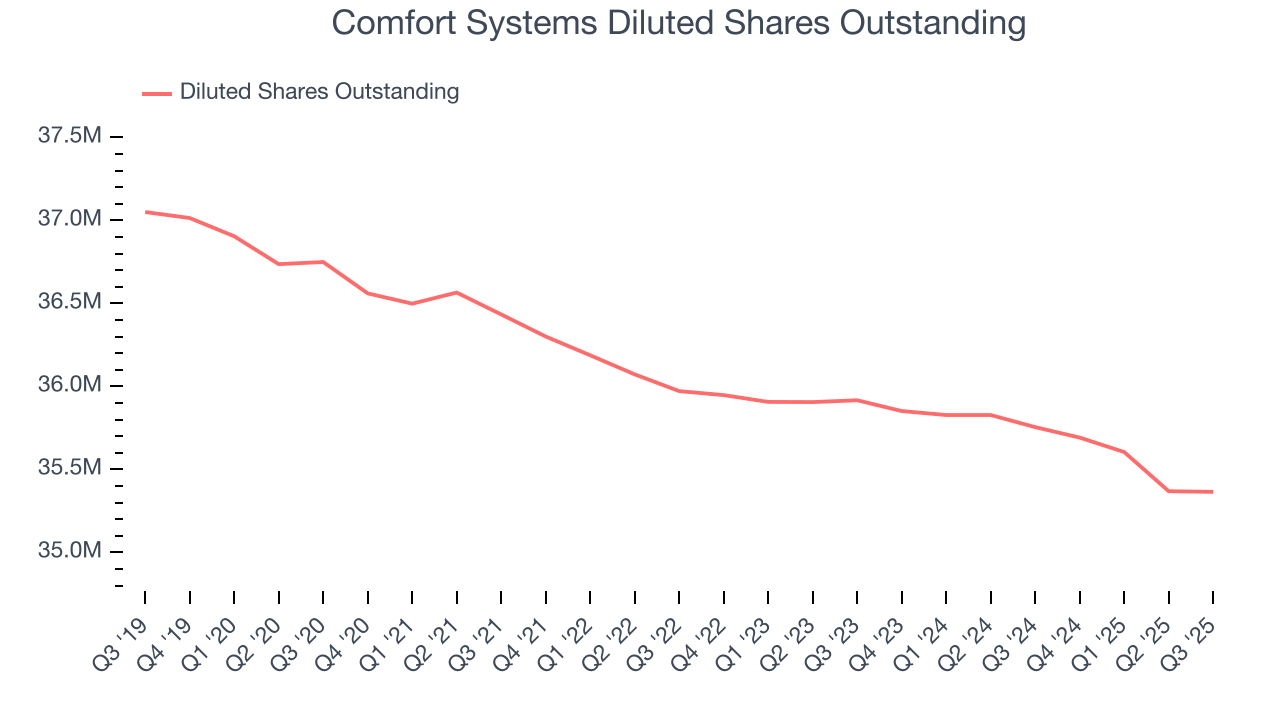
Like with revenue, we analyze EPS over a more recent period because it can provide insight into an emerging theme or development for the business.
For Comfort Systems, its two-year annual EPS growth of 71.9% was higher than its five-year trend. We love it when earnings growth accelerates, especially when it accelerates off an already high base.
In Q3, Comfort Systems reported EPS of $8.25, up from $4.09 in the same quarter last year. This print easily cleared analysts’ estimates, and shareholders should be content with the results. Over the next 12 months, Wall Street expects Comfort Systems’s full-year EPS of $23.62 to grow 6%.
9. Cash Is King
Free cash flow isn't a prominently featured metric in company financials and earnings releases, but we think it's telling because it accounts for all operating and capital expenses, making it tough to manipulate. Cash is king.
Comfort Systems has shown impressive cash profitability, enabling it to ride out cyclical downturns more easily while maintaining its investments in new and existing offerings. The company’s free cash flow margin averaged 9.1% over the last five years, better than the broader industrials sector.
Taking a step back, we can see that Comfort Systems’s margin expanded by 2.6 percentage points during that time. This is encouraging because it gives the company more optionality.
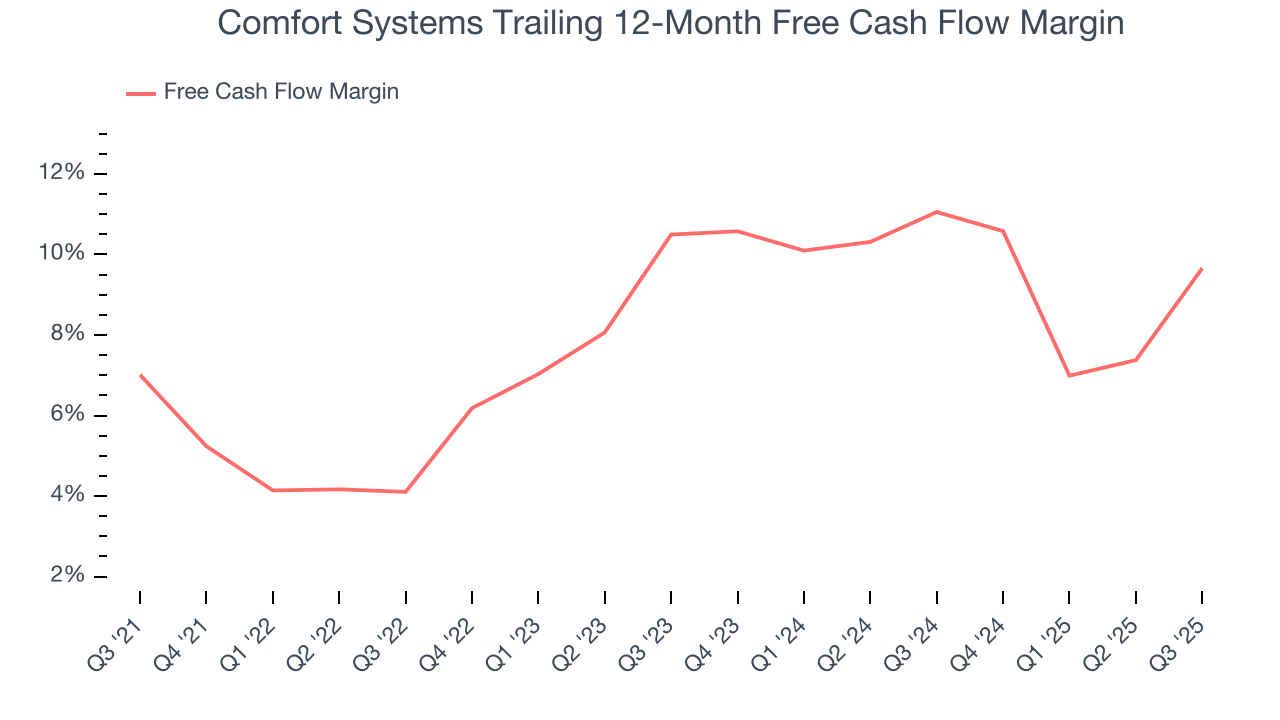
Comfort Systems’s free cash flow clocked in at $519 million in Q3, equivalent to a 21.2% margin. This result was good as its margin was 5.6 percentage points higher than in the same quarter last year, building on its favorable historical trend.
10. Return on Invested Capital (ROIC)
EPS and free cash flow tell us whether a company was profitable while growing its revenue. But was it capital-efficient? A company’s ROIC explains this by showing how much operating profit it makes compared to the money it has raised (debt and equity).
Comfort Systems’s five-year average ROIC was 30.8%, placing it among the best industrials companies. This illustrates its management team’s ability to invest in highly profitable ventures and produce tangible results for shareholders.
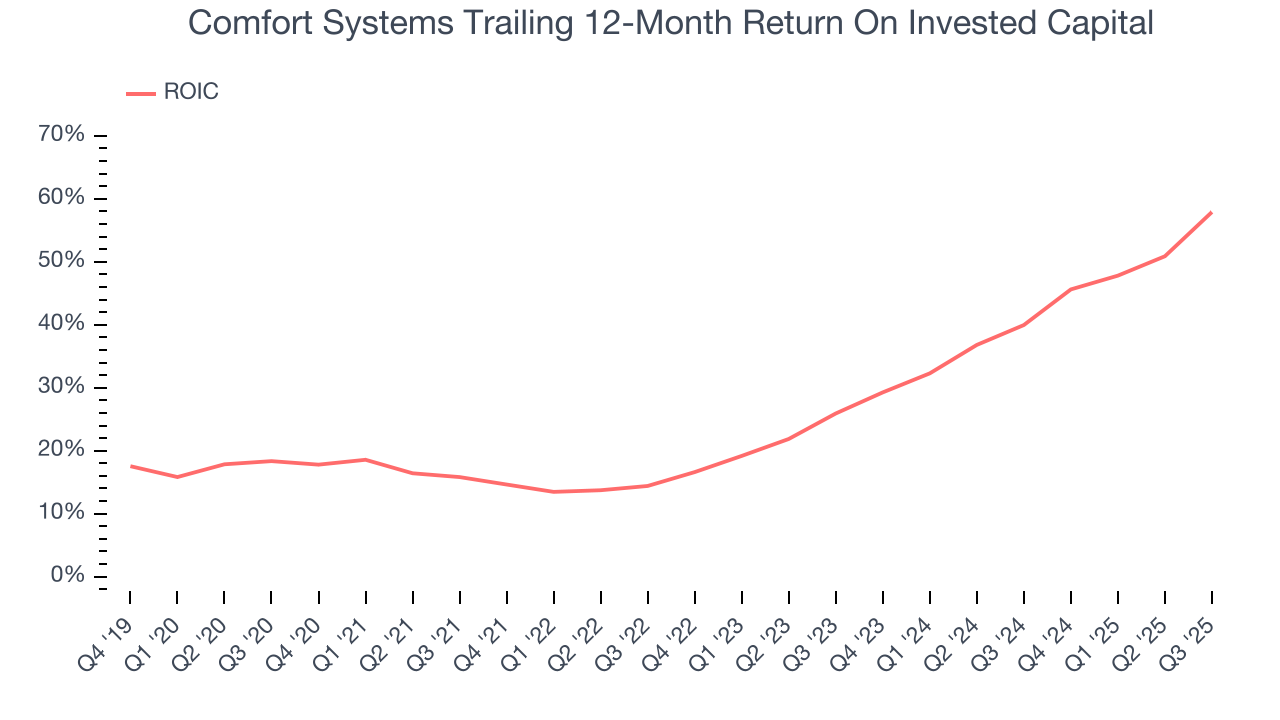
We like to invest in businesses with high returns, but the trend in a company’s ROIC is what often surprises the market and moves the stock price. Fortunately, Comfort Systems’s ROIC has increased significantly over the last few years. This is a great sign when paired with its already strong returns. It could suggest its competitive advantage or profitable growth opportunities are expanding.
11. Balance Sheet Assessment
Companies with more cash than debt have lower bankruptcy risk.
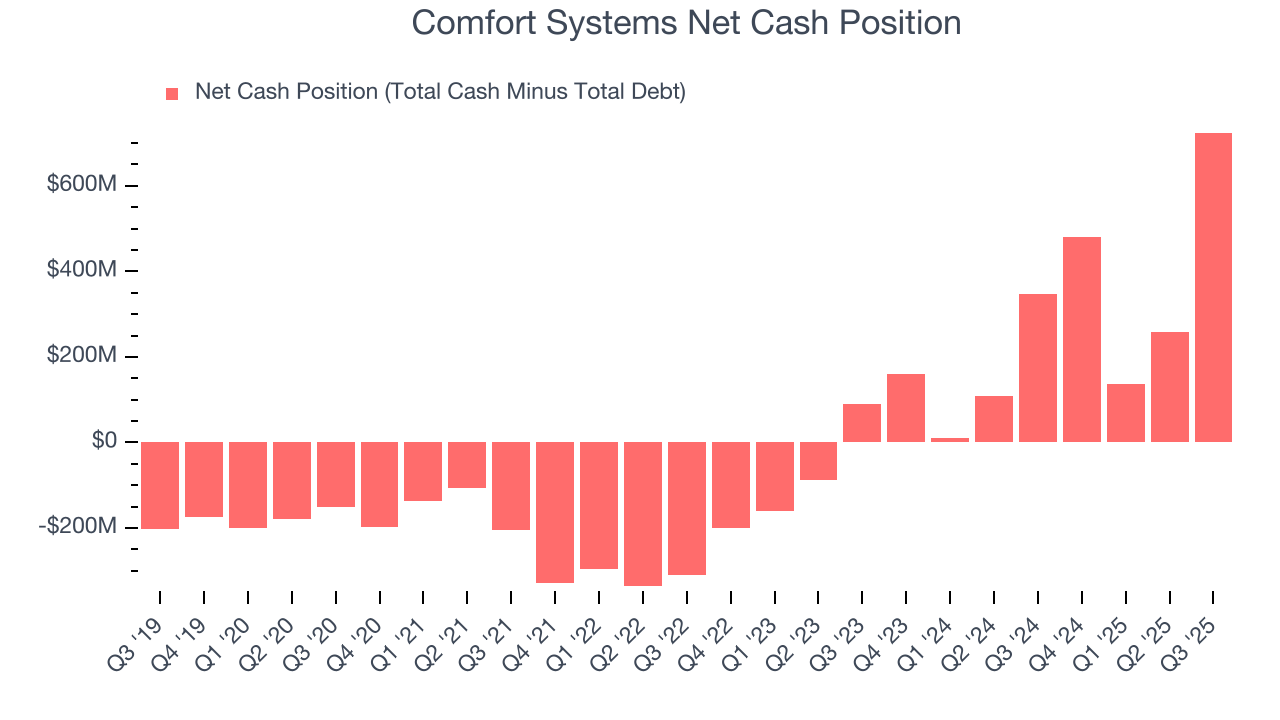
Comfort Systems is a profitable, well-capitalized company with $860.5 million of cash and $136 million of debt on its balance sheet. This $724.5 million net cash position is 2.6% of its market cap and gives it the freedom to borrow money, return capital to shareholders, or invest in growth initiatives. Leverage is not an issue here.
12. Key Takeaways from Comfort Systems’s Q3 Results
We were impressed by how significantly Comfort Systems blew past analysts’ backlog expectations this quarter. We were also glad its revenue and EPS both outperformed Wall Street’s estimates handily. Zooming out, we think this was a great print. The stock traded up 15.6% to $955 immediately after reporting.
13. Is Now The Time To Buy Comfort Systems?
Updated: December 5, 2025 at 10:22 PM EST
Before deciding whether to buy Comfort Systems or pass, we urge investors to consider business quality, valuation, and the latest quarterly results.
There is a lot to like about Comfort Systems. For starters, its revenue growth was exceptional over the last five years. And while its low gross margins indicate some combination of competitive pressures and high production costs, its backlog growth has been marvelous. On top of that, Comfort Systems’s expanding operating margin shows the business has become more efficient.
Comfort Systems’s P/E ratio based on the next 12 months is 34x. Looking at the industrials space today, Comfort Systems’s qualities as one of the best businesses really stand out, and we like it at this price.
Wall Street analysts have a consensus one-year price target of $1,133 on the company (compared to the current share price of $1,019), implying they see 11.2% upside in buying Comfort Systems in the short term.
